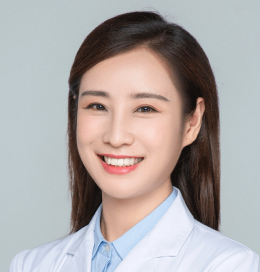
Professional Summary
Dr. Xiaomei Han is an attending physician with a Master of Medicine degree, specializing in dermatologic surgery. Her clinical focus lies in aesthetic scar revision and precision cosmetic suturing techniques. She has published several academic papers, led provincial-level research projects, and actively contributes to national and regional academic committees in the fields of dermatology, scar management, and medical aesthetics.
Education
2011–2014 | Master of Medicine in Otolaryngology – Head and Neck Surgery | Hebei Medical University | China
Academic Achievements
– Published several academic papers in domestic and international journals.
– Principal investigator of one project funded by the Hebei Provincial Department of Science and Technology.
– Principal investigator of one project funded by the Hebei Provincial Health Commission.
Areas of Expertise
– Aesthetic scar revision
– Precision cosmetic suturing
Academic Memberships & Appointments
– Youth Member, Dermatology Section, Expert Volunteer Committee of Integrated Chinese and Western Medicine, Chinese Volunteer Association
– Member, Scar Comprehensive Treatment Group, 20th Annual Meeting of the Chinese Society of Plastic Surgery (2023–2024)
– Member, Minimally Invasive Aesthetic Group, 20th Annual Meeting of the Chinese Society of Plastic Surgery (2023–2024)
– Youth Member, Aesthetic and Plastic Surgery Branch, Hebei Medical Doctor Association
– Member, Pediatric Plastic Surgery Committee, Hebei Pediatric Society
– Member, Dermatology and Laser Aesthetic Committee, Hebei Society of Integrated Traditional Chinese and Western Medicine
– Secretary, Skin Tumor Prevention Committee, Hebei Anti-Cancer Association
– Member, Burn and Plastic Surgery Branch, Hebei Medical Association
Abstract submitted for the 5th International Keloid Symposium
Title: Comprehensive Management of Large Auricular Keloids: The Role of the Innovative ABC Surgical Technique in a Multimodal, Multidisciplinary Approach
AUTHORS:
Xiao-Mei Han
Shao-Qian Jiang Cai-Xia Hu Ming Du Lu Zhao
AUTHORS’ AFFILIATIONS:
Department of Dermatology, The Fourth Affiliated Hospital of Hebei Medical University, No.12 healthy road, Changan District, Shijiazhuang, Hebei, China
Background:
Auricular Keloids, particularly those resulting from ear piercings, present significant cosmetic challenges for patients. Conventional treatment methods for larger keloids often fail to prevent significant changes in ear contours and are associated with a high recurrence rate. Achieving both low recurrence and optimal aesthetic restoration remains a major challenge in clinical practice. This study introduces a structured, multidisciplinary team (MDT)–guided management protocol integrating the innovative ABC surgical technique with preoperative assessment, precise surgical intervention, and multimodal postoperative management. The ABC surgical technique was specifically designed to balance complete lesion removal with maximal ear contour preservation, making it a key component in optimizing outcomes. By leveraging a collaborative approach among surgeons (dermatologists or plastic surgeons), radiation oncologists, and the nursing team, this model aims to improve treatment efficacy, minimize recurrence, and enhance aesthetic results.
Methods:
A total of 17 patients with 23 auricular keloid lesions were treated using an MDT-guided three-phase management strategy:
1. Preoperative Assessment & Planning (Multidisciplinary Collaboration)
Team Roles: A collaborative effort among Surgeons(dermatologists or plastic surgeons), radiation oncologists, and the nursing team ensured an individualized treatment approach. Three-Dimensional Evaluation: Comprehensive assessment of contour preservation, angle adjustment, and lesion minimization to guide precise surgical planning. Psychological support & patient education: Enhancing treatment adherence and preparing patients for postoperative care.
2. Surgical Procedure (ABC Surgical Technique, Led by the Surgical Team)
Arcuate incision design: Optimized flap planning to ensure adequate defect coverage and prevent deformities. Blind dissection for keloid lesion flap: Minimizing vascular disruption while preserving blood supply. Centrifugal keloid core serial shave excision: A gradual excision method balancing complete lesion removal with optimal contour restoration.
3. Postoperative Comprehensive Management (Collaborative Medical & Patient Engagement)
1) Medical Interventions
Postoperative radiotherapy as the primary modality, administered by radiation oncologists, with optimized dosage and irradiation strategies to prevent recurrence.
Adjunctive compression therapy, ensuring uniform pressure application to minimize the risk of lesion regrowth.
2) Patient-Guided Care (Nursing Team & Patient Collaboration)
Wound care education led by nursing professionals to prevent infections and promote healing.
Training on the proper use of compression devices, ensuring continuous and effective pressure distribution for optimal postoperative outcomes.
3) Long-Term Follow-Up (Ongoing MDT Monitoring & Adjustments)
Regular follow-up (2 months–2 years) conducted by surgeons and the nursing team, monitoring lesion recovery and adjusting management strategies as needed.
Aesthetic evaluation of ear contour restoration, ensuring high patient satisfaction and refining postoperative rehabilitation approaches.
Results:
Follow-up ranged from 2 months to 2 years (mean: 9 months).
Low recurrence rate: Only 1 recurrence (4.3%), significantly lower than conventional methods.
Aesthetic improvement: In non-recurrent cases, ear contours were well restored, appearing natural.
High patient satisfaction: Most patients reported excellent cosmetic outcomes.
The ABC surgical technique, in combination with postoperative radiotherapy and compression therapy, significantly enhanced treatment effectiveness, demonstrating a synergistic effect in reducing recurrence while preserving ear aesthetics. The meticulous excision approach in the ABC technique further contributed to improved contour restoration and reduced postoperative complications.
Conclusion:
This study presents an MDT-based structured treatment protocol integrating preoperative assessment, the ABC surgical technique, and multimodal postoperative care to provide a systematic and highly effective approach for auricular keloid disorder management. The ABC surgical technique plays a pivotal role in this model, offering a refined surgical method that enhances precision, optimizes contour restoration, and reduces recurrence risk. By leveraging multidisciplinary team collaboration among surgical, radiation, and rehabilitation specialists, this model ensures low recurrence rates, superior aesthetic outcomes, and high patient satisfaction, offering a promising framework for future clinical application.
Comprehensive Workflow Management of Auricular Keloid Surgery Patient










